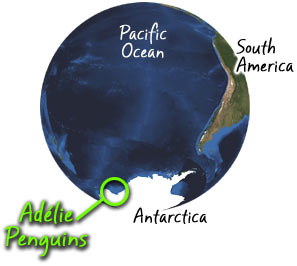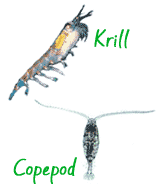 |
Scientific Name: Pygoscelis adeliae
Category: Seabirds
The Adélie penguin is one of the best known seabirds as it has been studied by Antarctic biologists for over 40 years. It is a medium-sized seabird standing 70-75 cm (28 inches) in height and weighing 3-6.5 kg (6.6-14.3 pounds). It is the most common of all penguins and it is estimated that there are over 2 million breeding pairs worldwide. Adélie penguins have the typical white front and black head, back and flippers, with a white ring around their eyes and a reddish-black tipped beak that is partially covered with feathers. Their flippers are used for swimming and steering. Their legs are pink and their feet are heavy claws that are used for climbing. Their stiff-tail feathers drag along the ground when they walk. They are one of only five species that live on the Antarctic pack ice and some of the islands surrounding the continent. Pack ice, one of Earth's largest habitats, is a mixture of floating ice and open water that constantly changes due to variations in ocean currents and atmospheric winds. Like all penguins, Adélie penguins cannot fly, but are excellent swimmers and divers. They can walk and belly slide great distances when necessary. They are well adapted to the pack ice habitat. Scientists have found that although they sometimes swim more than 1,200 km from the breeding sites and can dive as deep as 175 meters, they generally feed within 50 km of the colony, diving around 50 m. Adélie penguins can live up to 20 years and spend more than 90% of their lives at sea.

At about three years of age, Adélie penguins return to dry land in the same colony where they were born. They build nests close to the open water so they can feed at sea. These nests are built on slopes so that melting snow water in the spring will flow away from the nest. The nest is a small circle of hundreds of pebbles that are found on dry land. Adélie penguins are very competitive for space and nests, and will even steal rocks from each other's nests to build their own. The penguins usually breed with the same mate and lay two greenish-white eggs each year. Incubating duty involves both parents, each spelling the other so they can go to sea to feed. As the pack ice at the edge of the continent has not yet broken up, the trip to the sea for food may be 50 km or more. The penguins keep the eggs on their feet to keep them warm and sometimes the male will lay on them. These nesting rookeries have groups of six to hundreds of breeding penguins and are formed on islands, beaches, and headlands all the way around the Antarctic continent.
The chicks weigh approximately 86 grams (about 3 ounces) when they hatch and usually gain 100 grams (3.5 ounces) a day until they are about two-months-old. The chicks then leave the breeding ground, as they can fend for themselves and have already grown adult feathers. Often only one of the chicks survives. Scientists know more about Adélie penguin behavior during the breeding season (Oct.-Feb.), as they are in the ocean amidst the pack ice during the rest of the year.

Adélie penguins eat mostly krill and other small crustaceans, feeding in the open areas of the pack ice. Humans sometimes compete for their food source when fishers harvest krill. The penguins do not drink water, but they do eat snow. Seabirds, such as skuas, giant petrels, and leopard seals are their enemies, but Adélie penguins avoid them by living on the pack ice. The penguins can swim up to 25 km/hour when chased by their enemies, but usually swim about 8 km/hour.
Adélie penguins are not considered an endangered species, but their lives are being altered by climate change. Closer to the continent, the pack ice is loosening, creating new habitat for the penguins. This is beneficial for them. However, near the Antarctic Peninsula, pack ice is disappearing altogether and colonies will have to shift to the south in order to survive. This is bad for the penguins. Australian scientists are studying them in a unique way that limits the human handling of the birds. An electronic tag is implanted under the skin of a penguin and the scientists can monitor their weight, feeding patterns, migration directions, and other important data that are collected as the penguin walks over a weighing platform that is placed on the ground between the rookery and the sea. Scientists also put transmitters on the individual penguins and can track them via satellite.
Research Links Related to Adélie Penguin:
|
 |





